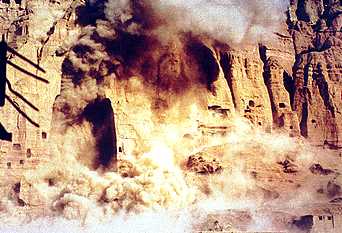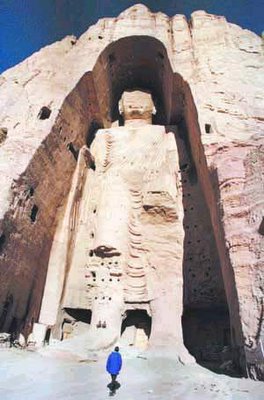Against Iconoclasm: Remembering the Bamiyan Buddhas

Bamiyan Buddhas

March 12, 2001
Destruction of the Bamiyan Buddhas
On March 12, 2001 the Buddhas in Bamiyan were destroyed in Afghanistan. Despite a resounding chorus of international condemnation, the Taliban ignorantly declared that the tenets of Islamic fundamentalism were more important than the world's artistic heritage. And so, the statues were blown apart, exactly six-months before the destruction of another pair of cultural icons, the Twin Towers of the World Trade Center in New York City.

The Bamiyan Buddhas were towering figures carved into the sandstone cliffs of what is now central Afghanistan sometime around the third century A.D. The statues were the tallest standing Buddhas in the world. Like classical Greek and Roman sculptures, which provided major influences on the Buddhist sculpture in this region, the Bamiyan Buddhas were originally brightly painted and most likely gilded. This region was known historically as Gandhara and occupied areas of present day North West India, Pakistan and Afghanistan. Gandhara was the most eastern region of the ancient world influenced by classical aesthetics, and among the first to portray the Buddha in human form.
In antiquity, the Gandharan region was a crossroads - caravans criss-crossed Bamiyan as they traded between the Roman Empire, China and India. For centuries the Buddhas stood sentinel to groups of wandering monks and merchants, who journeyed along the Silk Road, which ran from Rome to China. Beneath the statues, Buddhist monasteries clustered as places of sanctuary, but were abandoned in the 9th century as Islam displaced Buddhism in Afghanistan.
Since the destruction of the Bamiyan Buddhas the world has become embroiled in global battles over what director, Christian Frei, describes as a journey of "fanaticism and faith, terror and tolerance, ignorance and identity."
Christian Frei's film "The Giant Buddhas" , which screened this year at the Sundance Film Festival, is a richly nuanced view of our present reality caught in the long reach of artistic and cultural beauties and struggles.
In my own work, I struggle against iconoclasm. The drive to censor images has a long and violent history, and is more about the desire to control and make docile a population than it is about belief. I cringe at the destruction of all artistic productions.
Heinrich Heine's line from, "Almansor", is a call for constant vigilance:
"Where they have burned books, they will end in burning human beings."
("Dort, wo man Bücher verbrennt, verbrennt man am Ende auch Menschen.")
—Heinrich Heine, from his play Almansor (1821)


Gandharan Buddha
Destroyed: Formerly- National Museum, Kabul



Comments